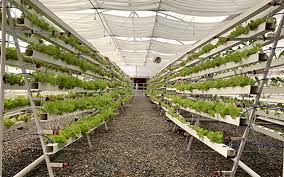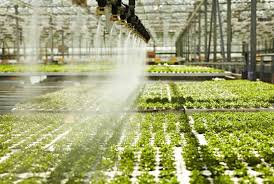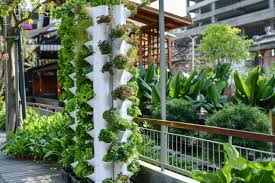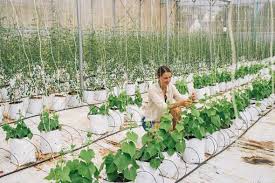Hydroponic systems have gained popularity in recent years as an innovative way to grow plants without soil. This method allows for greater control over the growing environment, making it possible to cultivate a wide variety of crops in limited space.
Hydroponics is especially appealing for urban gardeners, small-scale farmers, and anyone interested in sustainable agriculture. By using nutrient-rich water solutions, hydroponic systems provide plants with the essential nutrients they need to thrive while minimizing the use of land and water resources.
As the world faces challenges such as population growth and climate change, hydroponics offers a practical solution for producing fresh food in a more efficient manner.
One of the primary advantages of hydroponic systems is their ability to produce food in areas where traditional farming is not feasible. Urban environments, for instance, often lack the space for large fields and gardens, but hydroponics allows for vertical farming and indoor setups.
These systems can be installed on rooftops, in basements, or even in small backyards, making them accessible to many people.
Additionally, hydroponics can be used to grow a variety of plants, including fruits, vegetables, and herbs, all year round, regardless of external weather conditions.
Hydroponic systems are also known for their efficiency in resource usage. Traditional agriculture often relies heavily on soil, which can lead to erosion and depletion of nutrients over time.
In contrast, hydroponics uses water-based solutions to deliver nutrients directly to the plants’ roots, significantly reducing the amount of water needed for cultivation.
In fact, hydroponic systems can use up to 90% less water than traditional farming methods. This is especially important in areas facing water scarcity, as it allows for sustainable food production without putting additional strain on local water supplies.
Another key benefit of hydroponics is the potential for faster plant growth and higher yields. In a controlled environment, plants can be nurtured under optimal conditions, free from pests and diseases that often affect soil-grown crops.
This means that growers can harvest crops more frequently and produce more food in a shorter period. Hydroponic systems also eliminate the need for harmful pesticides and herbicides, making them a healthier choice for consumers.
For beginners interested in hydroponics, understanding the different types of systems available is crucial. There are several hydroponic methods, including nutrient film technique (NFT), deep water culture (DWC), and aeroponics, each with its unique advantages and challenges. As a novice, it’s essential to choose a system that fits your space, budget, and the types of plants you wish to grow.
Getting started with hydroponics may seem daunting, but many resources and communities are available to support new growers. Online forums, local workshops, and hydroponic supply stores can provide valuable information and guidance.
Hydroponic systems present an exciting opportunity for those looking to grow their own food in a sustainable and efficient manner. With their ability to conserve resources, produce faster growth rates, and flourish in limited spaces, hydroponics is becoming an increasingly attractive option for beginner gardeners.
As you embark on your hydroponic journey, keep in mind that the initial setup and learning process may require time and effort, but the rewards of fresh, home-grown produce will be well worth it.
Benefits of Hydroponic Systems

1. Space Efficiency: Hydroponic systems require less space than traditional soil gardening. This allows for more plants to be grown in a smaller area, making it ideal for urban environments.
2. Water Conservation: Hydroponics uses significantly less water compared to traditional farming methods. Water is recirculated in the system, minimizing waste and reducing the overall demand for this precious resource.
3. Faster Growth Rates: Plants grown hydroponically often grow faster than those in soil. The nutrients are delivered directly to the roots, promoting rapid growth and higher yields.
4. No Soil-borne Pests and Diseases: Growing without soil eliminates many common pests and diseases that affect traditional crops. This reduces the need for chemical pesticides and results in healthier plants.
5. Year-round Production: Hydroponic systems can be set up indoors or in controlled environments, allowing for year-round cultivation regardless of external weather conditions. This provides consistent harvests and income potential.
Types of Hydroponic Systems
1. Nutrient Film Technique (NFT): In NFT systems, a thin film of nutrient-rich water flows over the roots of plants. This method ensures that plants receive adequate nutrients and oxygen, promoting healthy growth.
2. Deep Water Culture (DWC): In DWC systems, plant roots are suspended in a nutrient solution, with air stones providing oxygen. This system allows for rapid growth and is easy to manage.
3. Ebb and Flow (Flood and Drain): Ebb and flow systems periodically flood the grow bed with nutrient solution and then drain it away. This method ensures that roots receive nutrients and oxygen alternately, promoting healthy growth.
4. Aeroponics: In aeroponic systems, plant roots hang in the air and are misted with a nutrient solution. This high-tech method uses minimal water and provides excellent oxygenation for the roots.
5. Wick System: The wick system relies on a wick to draw nutrient solution from a reservoir to the grow medium. This passive method is simple and suitable for small-scale growers.
Read Also: 18 Medicinal Health Benefits Of Iris qinghainica (Qinghai Iris)
Key Components of Hydroponic Systems

1. Growing Medium: Although hydroponics does not use soil, it still requires a growing medium such as rock wool, clay pellets, or coconut coir to support plant roots and retain moisture.
2. Nutrient Solution: This is a water-based solution containing essential nutrients required for plant growth. The nutrient mix can be tailored to the specific needs of different plant species.
3. Reservoir: The reservoir holds the nutrient solution and is a critical component of most hydroponic systems. It can vary in size depending on the scale of the operation.
4. Pumping System: Pumps are necessary to circulate the nutrient solution throughout the system. They ensure that plants receive a continuous supply of nutrients and oxygen.
5. Lighting: In indoor hydroponic setups, artificial lighting is often required to provide adequate light for plant growth. Grow lights simulate sunlight and can be adjusted based on the plants’ needs.
Choosing the Right Hydroponic System for Beginners
1. Nutrient Film Technique (NFT): NFT is a great choice for beginners because it is relatively simple to set up and maintain. It allows for efficient nutrient delivery and is suitable for growing leafy greens.
2. Deep Water Culture (DWC): DWC is another beginner-friendly option. It requires minimal equipment and is easy to manage. The plants are suspended in nutrient-rich water, which promotes fast growth.
3. Ebb and Flow (Flood and Drain): This system offers a balance of nutrient and oxygen delivery, making it suitable for a variety of plants. It’s straightforward to set up and allows beginners to experiment with different crops.
4. Wick System: The wick system is the simplest hydroponic method. It doesn’t require pumps or timers, making it perfect for beginners. It’s ideal for small plants and herbs.
5. Aeroponics: While slightly more complex, aeroponics can be a fun challenge for beginners. It allows for high growth rates and requires less water, but it needs careful monitoring of moisture levels.
Essential Nutrients for Hydroponic Plants
1. Nitrogen (N): Essential for plant growth, nitrogen helps in the development of leaves and stems. It is a vital component of amino acids and proteins.
2. Phosphorus (P): Phosphorus is crucial for root development and flowering. It aids in energy transfer and the synthesis of nucleic acids.
3. Potassium (K): Potassium regulates various physiological processes, including water uptake and enzyme activation. It improves overall plant health and disease resistance.
4. Calcium (Ca): Calcium is necessary for cell wall structure and stability. It helps in root growth and development and plays a role in nutrient absorption.
5. Magnesium (Mg): Magnesium is essential for photosynthesis, as it forms the core of chlorophyll. It also helps in enzyme activation and energy production.
6. Trace Elements: Iron, manganese, zinc, copper, boron, molybdenum, and chlorine are required in smaller amounts but are equally important for plant health.
Read Also: Bedbugs: Description, Damages Caused, Control and Preventive Measures
Step-by-Step Guide to Setting Up a Hydroponic System

1. Choose Your Hydroponic System: Select the right type of hydroponic system based on your space, budget, and experience level. Consider systems like DWC or the wick system for beginners.
2. Gather Materials: Collect all necessary materials, including containers, a reservoir, pumps, growing medium, nutrient solution, and lighting (if needed).
3. Prepare the Growing Area: Ensure your growing area is clean, well-lit, and has easy access to water and electricity. Create a suitable environment for your plants.
4. Assemble the System: Set up your hydroponic system according to the chosen method. Follow the manufacturer’s instructions for any specific equipment.
5. Fill the Reservoir: Mix your nutrient solution according to the instructions on the nutrient package. Fill the reservoir and check the pH level to ensure it is suitable for your plants.
6. Plant Your Seeds or Seedlings: Add your growing medium to the containers, plant your seeds or seedlings, and ensure they are securely in place.
7. Monitor and Maintain: Regularly check the nutrient levels, pH, and overall health of your plants. Adjust the nutrient solution and environmental conditions as needed.
Best Plants for Hydroponic Growing
1. Lettuce: Lettuce is a fast-growing, low-maintenance crop ideal for hydroponics. It thrives in various hydroponic systems and can be harvested in just a few weeks.
2. Spinach: Spinach is another excellent choice for hydroponics. It grows quickly and provides a high yield, making it a popular option for home growers.
3. Herbs (Basil, Mint, Cilantro): Many herbs flourish in hydroponic systems. They grow rapidly and can be harvested multiple times, offering a great return on investment.
4. Tomatoes: Hydroponic tomatoes can produce high yields and excellent flavor. They require a bit more care than leafy greens but are well-suited for indoor hydroponic systems.
5. Strawberries: Strawberries can thrive in hydroponics and offer a delicious, high-value crop. They need proper lighting and care to ensure good fruit production.
Common Mistakes to Avoid in Hydroponics
1. Ignoring pH Levels: Failing to regularly check and adjust the pH level of your nutrient solution can lead to nutrient deficiencies. Most hydroponic plants thrive at a pH of 5.5 to 6.5.
2. Overwatering or Underwatering: Hydroponic systems do not require traditional watering methods, but it’s essential to maintain the right moisture levels. Too much water can suffocate roots, while too little can cause stress.
3. Neglecting Nutrient Solutions: Overlooking the nutrient balance can lead to either deficiencies or toxicities. It’s important to follow a proper feeding schedule and adjust as plants grow.
4. Inadequate Lighting: Insufficient light can stunt plant growth and reduce yields. Ensure that your plants receive adequate light based on their specific needs and growth stage.
5. Poor Air Circulation: Stagnant air can lead to mold and disease. Adequate ventilation is crucial for maintaining a healthy growing environment and preventing pests.
6. Skipping Regular Maintenance: Neglecting routine maintenance, such as cleaning and checking equipment, can lead to system failures. Regular checks will ensure everything functions properly.
Maintenance and Care for Hydroponic Systems
1. Regular Cleaning: Clean your system, including the reservoir and tubing, every few weeks to prevent algae growth and contamination. Use non-toxic cleaners to avoid harming your plants.
2. Monitor Water Levels: Keep an eye on the water levels in your reservoir. Top up with fresh nutrient solution as needed to ensure consistent nutrient availability.
3. Check Nutrient Concentration: Regularly test and adjust the nutrient concentration in your solution. Use a TDS (Total Dissolved Solids) meter for accurate readings.
4. Inspect for Pests: Regularly check your plants for any signs of pests or diseases. Early detection can help prevent major infestations and crop loss.
5. Maintain Proper Temperature and Humidity: Monitor the environmental conditions within your growing area. Ensure that temperature and humidity levels are within the optimal range for your plants.
6. Adjust Lighting as Needed: As plants grow, they may require adjustments in light height or intensity. Ensure they receive adequate light throughout their growth cycle.
Troubleshooting Common Hydroponic Issues
1. Yellowing Leaves: Yellowing leaves may indicate a nitrogen deficiency or pH imbalance. Test the nutrient solution and adjust accordingly to restore plant health.
2. Wilting Plants: Wilting can be a sign of overwatering or underwatering. Check the root zone for excess moisture or dryness, and adjust your watering practices.
3. Root Rot: Root rot often occurs in overly wet conditions. Ensure proper aeration and drainage, and consider using beneficial bacteria to promote healthy roots.
4. Slow Growth: If plants are growing slowly, check for insufficient light, poor nutrient balance, or inadequate temperatures. Addressing these factors can promote faster growth.
5. Mold and Algae Growth: Excess moisture and stagnant air can lead to mold or algae. Increase air circulation and reduce humidity to mitigate these issues.
6. Nutrient Burn: Brown tips on leaves can indicate nutrient burn due to excessive nutrient concentration. Dilute the nutrient solution and monitor your feeding regimen.
Do you have any questions, suggestions, or contributions? If so, please feel free to use the comment box below to share your thoughts. We also encourage you to kindly share this information with others who might benefit from it. Since we can’t reach everyone at once, we truly appreciate your help in spreading the word. Thank you so much for your support and for sharing!
Read Also: Complete Composting Guide for Beginners
Frequently Asked Questions
We will update this section soon.

